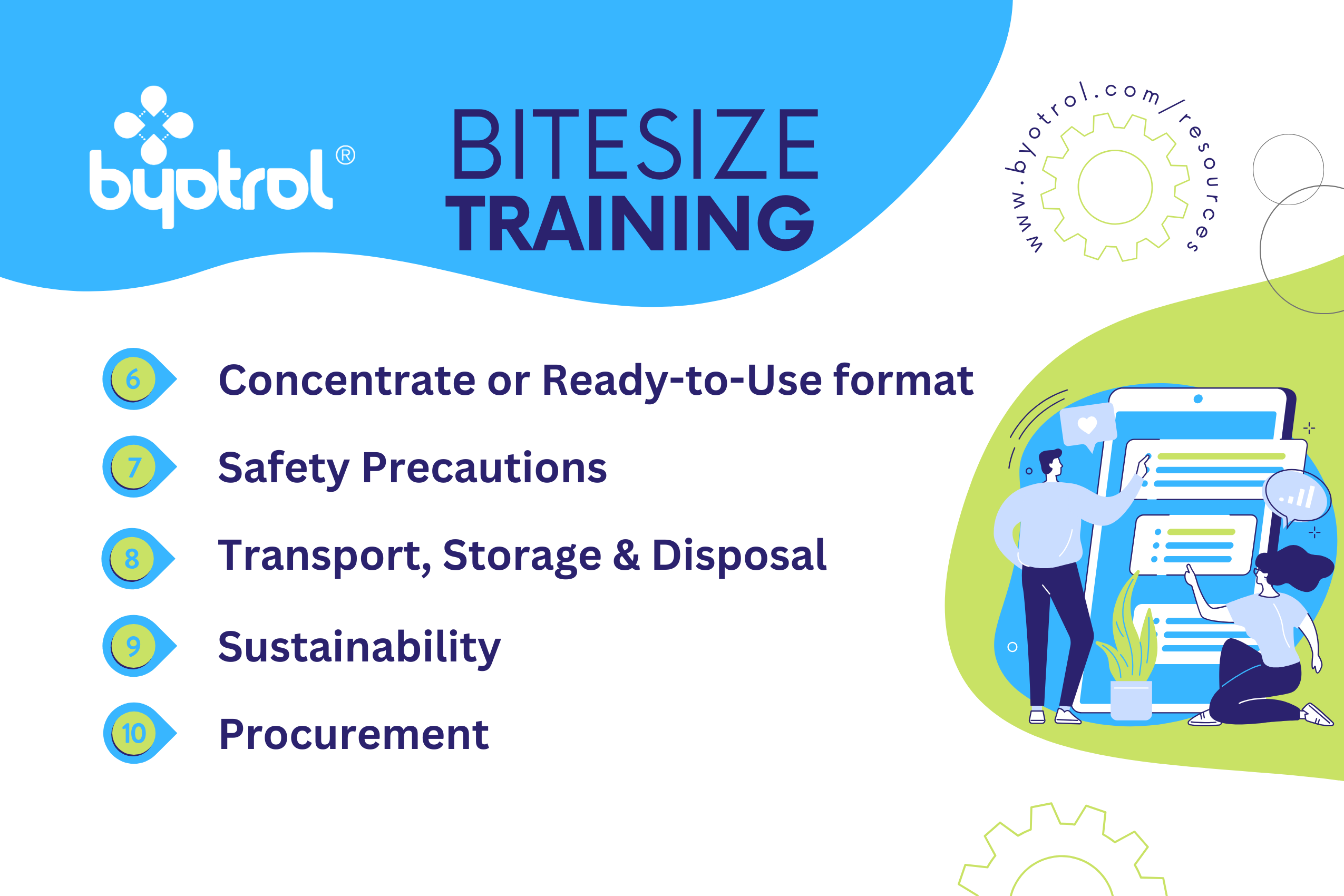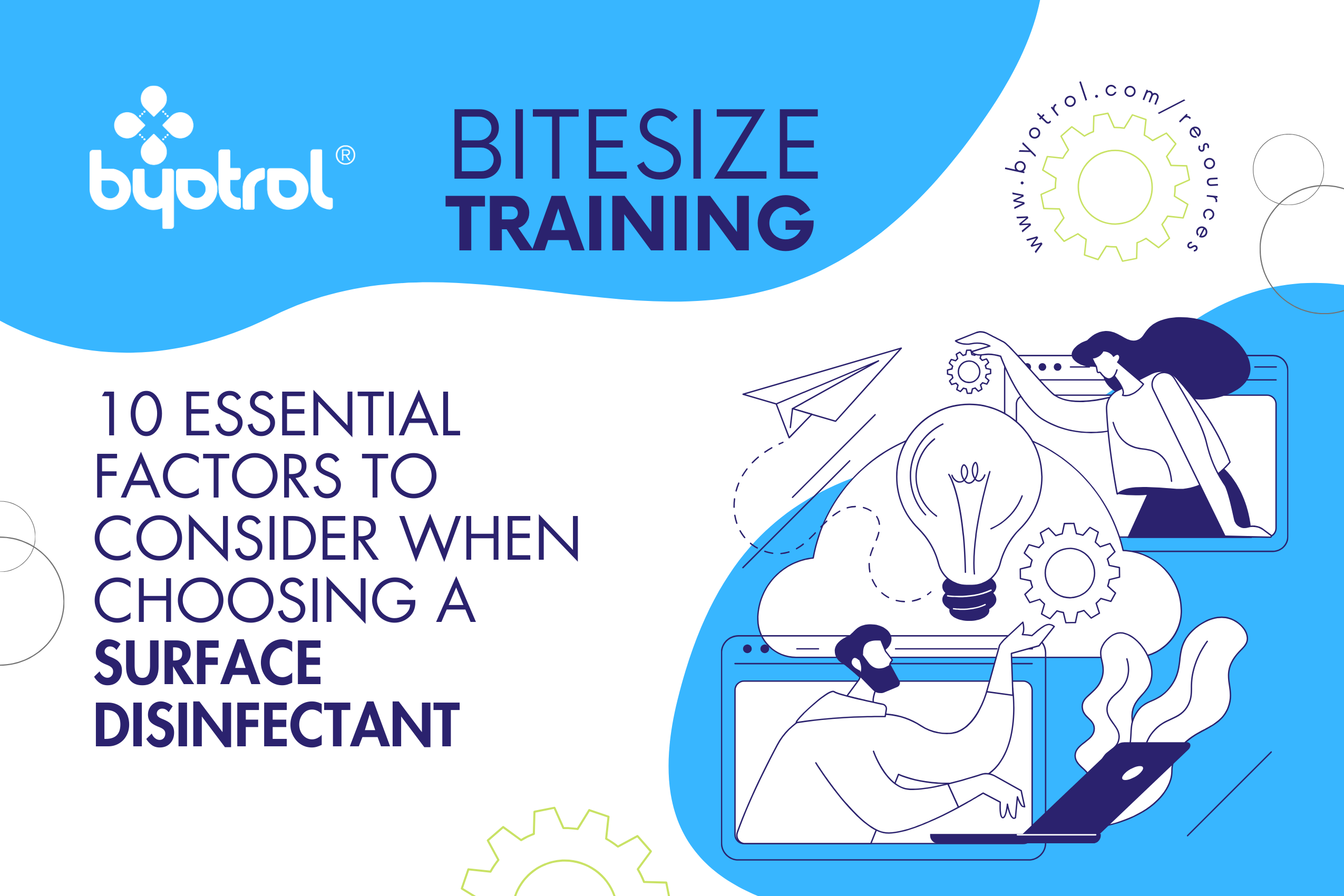When faced with the task of selecting an appropriate disinfectant for your organisation, it’s important to consider more than just the claims. This article will give you 10 key factors to take into consideration when searching for the most appropriate disinfectant for your requirements.

1. Intended Use
Depending upon the nature of the application, disinfectants may require specific regulatory approval. For example, disinfectants used in hospital settings on equipment such as wheelchairs must be registered medical devices, in a specific class. Disinfectants used in veterinary applications should be biocidal disinfectants and must be appropriately tested for use in product type 3 according to the Biocidal Product Regulations (BPR). For more guidance on different applications of disinfectants, see our previous blog post here.
2. Method of Application
The intended use or environment may also affect the application of the disinfectant, which can be sprayed, mopped, applied via a pre-dosed wipe, aerosolised, or fogged using specialist equipment. Determining what is the most appropriate method of application will help to determine the best disinfectant product for your requirements.
3. Efficacy Claims
Disinfectant products boast diverse efficacy claims, ranging from bactericidal to virucidal, including some claims of efficacy against specific organisms, such as Coronavirus. Under the Biocidal Products Regulation, adherence to specific European (EN) test standards is essential for making claims. More information on the required European standards per claim can be found here.
Comprehensive testing against specified organisms involves testing in both suspension and on surfaces. This is to ensure the product works in real-life situations. Products only tested in suspension may show a pass result but are less likely to be representative of how the product works outside of laboratory test conditions. Additionally, the BPR Efficacy Guidance often specifies the temperature, maximum contact time, soil conditions and log reduction needed to pass the test. By checking that your supplier has the test results to back up their claims using the latest EN standards (suspension and surface) against the required organisms under the relevant temperature, soil conditions and contact time, you can be confident that the product is working as claimed.
Additional accreditation or approval can be obtained from government agencies or third-party agencies for other purposes, for example, use of disinfectants in outbreaks of notifiable diseases require a Defra-approved disinfectant.
4. Contact Time
Contact time refers to the length of time the disinfectant is present on the surface you are disinfecting.
Under the BPR Efficacy Guidance, the contact time for different tests is often specified. This can range from 30 seconds to 60 minutes dependent on the test and claim being made. In some cases, contact times above 60 minutes can be used.
For some organisations, a shorter contact time would be required, to minimise disruption of services. However, in some settings in order to reduce the health and safety risks, lower dilutions and extended contact times might be more appropriate.
It is imperative to ensure the specified contact time is being followed to ensure the product is working as claimed. In some cases, the contact time may vary between different organisms or applications. If a product does not specify the contact time, you should verify this with your supplier.
5. Soil Conditions
Different environments will have varying levels of soil. For example, a vehicle used to transport animals will generally have much higher levels of soil than a laboratory. The same efficacy performance should not be assumed regardless of the level of soil present in the environment.
Disinfectants can be tested in either low or high soil so it’s always important to check if pre-cleaning using a detergent is required prior to disinfection. If the product has been tested in low soil levels, the directions for use should specify pre-cleaning or soil removal prior to disinfection. Alternatively, if you have access to the test reports or test results for the product, you can check which soil levels it has been tested under. A disinfectant tested in low soil and used in high soil environments may not perform the claims stated on the label.

6. Concentrated Formats or Ready-to-Use
Understanding the product’s format, whether ready-to-use or concentrated, is vital. While ready-to-use formats reduce the risk of end-user error during dilution, they are often more expensive in use than concentrated disinfectants. Concentrated products, despite requiring dilution, generally offer more liquid per price than ready-to-use counterparts, but correct training needs to be provided to end-users to reduce the risk of misuse.
Dilution rates can vary based on efficacy claims, with some organisms requiring a much more concentrated solution than others. For example, a product effective against bacteria at a specific dilution may not always be effective against viruses. This emphasises the importance of checking the required dilution for the intended use.
Disinfectant products should always specify the dilution rate to be used, particularly if they differ per organism. Products stating “general” or “high” levels of disinfection may lead to confusion when targeting specific organisms or in outbreak situations.
For more information on dilution rates, and guidance on the importance of correct dilution rates, click here.
7. Safety Precautions
The safety precautions associated with disinfectants are contingent on their chemical composition and dilution rates. Concentrated products typically entail harsher hazards, underscoring the necessity of reading safety data sheets (SDS) and product labels before use. When dealing with concentrated products during the dilution step, diligence in adhering to safety and personal protective equipment (PPE) precautions is crucial. Once diluted, the disinfectant may have different safety precautions to those specified on the concentrated product’s SDS or label. Requesting an SDS for each specified dilution ensures accurate information on hazards and precautions, accounting for potential variations per dilution.
The health and safety of your team should be paramount and during the introduction of a new disinfectant product special care should be taken with end-user training and communication to ensure any challenges or concerns are documented and resolved in collaboration with your disinfectant manufacturer.
8. Transport, Storage & Disposal Requirements
Safety data sheets also contain guidance on the transport and storage requirements for disinfectants, as well as the disposal of used or unwanted disinfectants. How suited your organisation is to meet these requirements may well be a factor to consider when selecting a new disinfectant for your organisation.
Whether or not a product is hazardous determines the conditions required when transporting it from a distributor to your location and can affect the cost of transportation greatly. In some cases, certain areas may not allow the storage of hazardous chemical products, in the event of a spillage. Therefore, it is worth discussing these requirements in advance with any service providers who would need to handle the product.
9. Sustainability
Many organisations are keen to employ the use of more sustainable products and services, to meet their own environmental objectives. Disinfectants by their very nature are designed to destroy microorganisms, and used irresponsibly, can damage the environment and wildlife. Engaging in meaningful dialogue with your disinfectant manufacturer with regards to their own sustainability initiatives, will ensure that your organisations are suitable aligned.
It is important to note that advertising biocidal products as ‘environmentally friendly’ is not allowed according to Article 69 of the BPR. Biocidal product labels and advertisements must not describe the product in any way which is misleading in relation to the risks to human, animal or environmental health. Phrases which are considered to be misleading and must not be used include low-risk, non-toxic, harmless, natural, environmentally friendly, animal friendly or any similar terms.
10. Procurement
Whilst the above factors should form the basis for how appropriate products are selected, cost is of course an important factor, however, selecting disinfectant products based on cost alone is not an advisable approach. Whilst a product may be the cheapest of your shortlisted choices, the potential cost incurred by a quality issue, an outbreak of an infectious disease, or the cost of resolving staff safety issues should not be underestimated.
In essence, the above considerations of application, efficacy, contact time, soil conditions, dilution rate and associated safety precautions should form part of a holistic selection process for disinfectants, which often requires the collaboration of multiple departments. By incorporating these factors, organisations can confidently prioritise efficiency, efficacy, and safety in their biosecurity strategy.
To request further assistance with your biosecurity strategy from a member of our team, please contact us.
